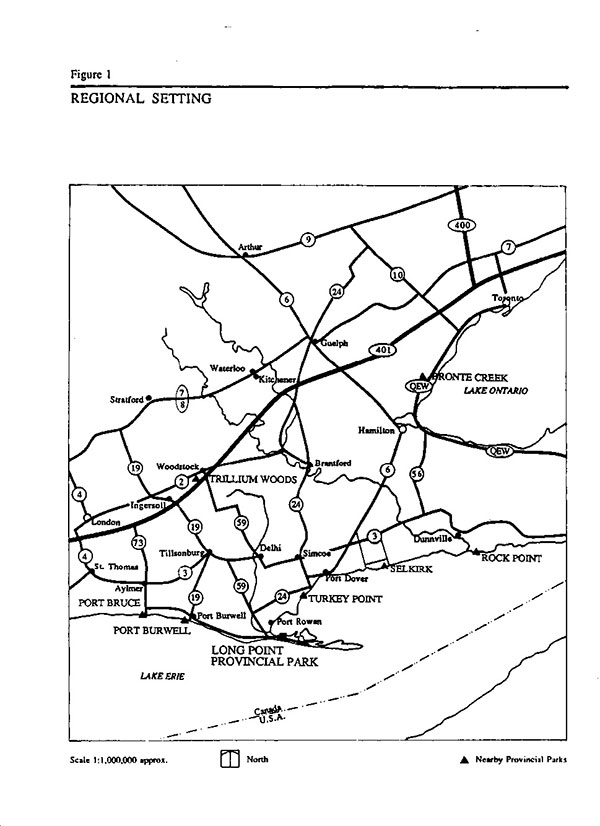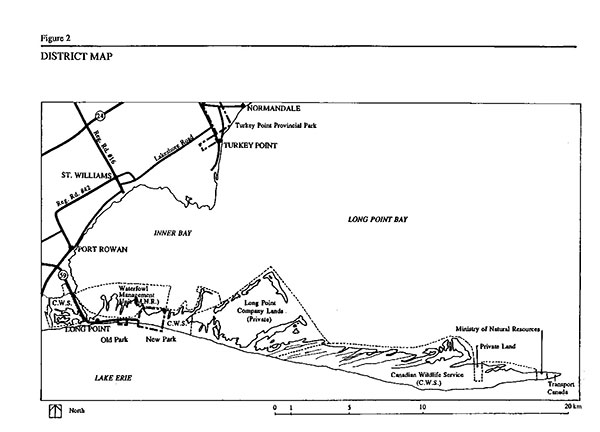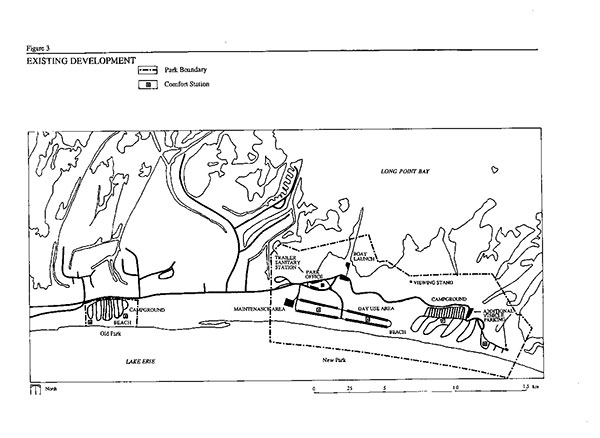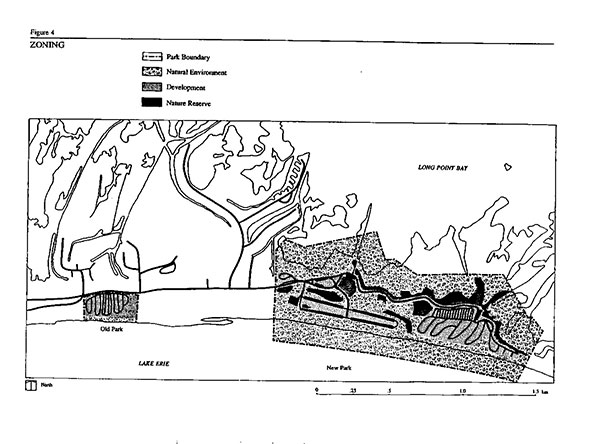Long Point Provincial Park Management Plan
This document provides policy direction for the protection, development and management of Long Point Provincial Park and its resources.
Ministry of Natural Resources
Lyn McLeod
Minister
August, 1989
© 1989, Queen’s Printer for Ontario
Printed in Ontario, Canada
Additional copies of this publication are obtainable only from: Ministry of Natural Resources
Simcoe District
P0 Box 706
548 Queensway West
Simcoe, Ontario
N3Y 4T2
(519-426-7650)
Note: This document has been scanned and formatted, and therefore is slightly different from the original version - March 2002.
Approval statement
We are pleased to approve the Long Point Provincial Park Management Plan as official policy for the management and development of this park. The plan reflects this Ministry’s intent to protect the natural and recreational features of Long Point Provincial Park and maintain high quality opportunities for outdoor recreation and heritage appreciation for both residents of Ontario and visitors to the Province.
David J. Johnstone
Regional Director
Southwestern Region
N.R. Richards Regional
Director, Parks and
Recreational Areas Branch
1.0 Introduction
Long Point Provincial Park is located near the base of the Lake Erie sand spit known as Long Point, which extends easterly some 32 km into the lake (Figure 1). The park was established under the authority of the Long Point Park Act in 1921, with an area of 800 hectares (ha). A commission administered and operated the park over the next 34 years during which time some parkland was sold for cottage lots. In 1955 the commission was dissolved and the area was designated as a park under the Provincial Parks Act. The park, as established by Regulation73/57 under the Provincial Parks Act, now consists of 2 units occupying 140 ha; the Old Park extends over 5 ha and the New Park over 135 ha (Figures 2 and 3).
The lands and waters around Long Point Provincial Park are administered by a variety of interests. The Canadian Wildlife Service administers both the Long Point National Wildlife Area, over 3200 ha in size, and the Big Creek National Wildlife Area. Close by is the Lee Brown Waterfowl Management Unit, operated by the Long Point Region Conservation Authority. The Ontario Ministry of Natural Resources administers not only the park, but the adjacent Crown marsh. Private properties make up the remainder of the area. Altogether, these holdings constitute a natural resource of international significance.
As an integral part of the point, the park contains representative plant communities and landforms, and hosts a number of significant plant and animal species.
To allow public use and enjoyment of this resource, Long Point Provincial Park offers a variety of recreational facilities. These include 268 campsites, parking for 800 cars in the day use area, 2.2 km of excellent sand beach, a 6.5 ha picnic area, and a boat launch. Port Rowan, the nearest service centre, and businesses on Long Point itself, provide a variety of commercial services for campers. These amenities, along with excellent fishing, nature viewing and waterfowl hunting, attract visitors primarily from Southwestern Ontario and the Toronto - Hamilton - Niagara region. The result is a July - August campsite occupancy rate that averages about 72% (1988).
2.0 Classification
Long Point Provincial Park is classified as a Recreation Park to recognize the outstanding recreational opportunities available within the park. Zoning of the park will provide a mechanism for protecting the special and unique environmental features of the park.
3.0 Goal
To provide a variety of recreational opportunities which utilize the natural features and historic resources of long point Provincial Park while protecting the significant ecological features of the park.
4.0 Objectives
Long Point Provincial Park contributes towards meeting the objectives of the provincial park system.
4.1 Protection
To protect provincially significant elements of the natural and cultural landscape of Ontario.
The Long Point sand spit has been selected as a World Biosphere Reserve under UNESCO's Man and the Biosphere programme, in recognition of its significance as a natural feature. Biosphere Reserves are examples of characteristic ecosystems of one of the world’s natural regions. These are places where government decision makers, scientists, managers and local people cooperate in developing a model programme for managing land and water to meet human needs while conserving natural processes and biological resources.
Forming a small part of this reserve, Long Point Provincial Park contains a number of provincially significant natural features, including sand dunes, wet meadows, a dry prairie complex, and marshes. These areas will receive careful attention and protection, through zoning and site specific plans, to restrict and control use. Much of the park is sensitive to the impact of recreational use. Care will be taken to provide recreational opportunities in a manner that minimizes impact on the sensitive resource
Figure 1 - Regional Setting

Enlarge Figure 1 - Regional Setting map
Figure 2 - District Map

Enlarge Figure 2 - District map
4.2 Heritage appreciation
To provide opportunities for exploration and appreciation of the outdoor natural and cultural heritage of Ontario.
Opportunities will be provided at the park to increase awareness of the sensitivity and significance of the sand spit-marsh ecosystem, and the inter-relationship of the various biological communities.
Long Point’s location on a major bird migration corridor provides opportunities for bird watching. This activity will receive active support.
The rich history of the Long Point area, featuring French explorers, shipwrecks, lighthouses, and the Long Point Company, will be emphasized.
4.3 Recreation
To provide a range of facility based outdoor recreation opportunities.
Long Point Provincial Park will assist Simcoe District in meeting district-wide recreation targets by providing opportunities for camping and day use activities. The park is heavily used during the peak summer season with a July - August campsite occupancy rate of 72% (1988). Use is lighter during the May - June and
September - October periods, but a significant level of use still occurs, due to fishing, hunting and bird-watching activities.
Long Point Provincial Park also serves as the administrative base for the controlled hunting of waterfowl that takes place each fall in the adjacent Long Point Waterfowl Management Unit. Although no hunting occurs within its boundaries, the park plays an integral part in meeting the district’s target of providing 31,000 annual waterfowl hunting opportunities.
Swimming, sunbathing, picknicking, boating, fishing, hunting and camping are the most popular recreational pursuits that bring visitors to Long Point Provincial Park. The appropriate facilities and opportunities for those pursuits will be retained. However, the number of campsites within the park will not be increased. Additional demand for camping will be met by directing campers to nearby provincial parks (Turkey Point, Port Burwell and Selkirk) as well as other camping facilities in the area. Boat launching and mooring facilities will continue to offer park visitors access to Long Point Bay.
4.4 Tourism
To provide Ontario’s residents and out-of-province visitors with opportunities to discover and experience the distinctive regions of the province.
Over 114,000 visitors enjoyed Long Point Provincial Park in 1988. Spending by visitors will continue to make a significant contribution to the local and provincial economies.
Park facilities and features will be utilized to encourage and enhance tourism in the Long Point area. Park staff will encourage park visitors to discover and experience the distinctive features of the park and the surrounding area and will seek opportunities to work co-operatively with the private sector to publicize the variety of recreational opportunities that are available outside the park.
5.0 Park boundaries and zones
A minor amendment to the park boundary will be recommended to incorporate the Crown Land beach fronting the Old Park campground into Long Point Provincial Park.
Three zones will be designated to reflect the potential and the limitations of the landscape to accommodate particular types of development and to protect significant features (Figure 4).
5.1 Development zone (33 ha)
Most of the intensive recreational activity will occur in the development zone, which includes the existing campgrounds, day use area, boat launch, parking lots, and the areas immediately adjacent to the administrative and maintenance buildings. Development in this zone will be carried out so that the facilities are compatible with the surrounding environment and impacts on the environment are minimized. Appropriate site design and construction techniques will be applied due to the sandy soil frequently found within this zone.
Figure 3 - Existing Development

Enlarge Figure 3 - Existing Development map
Figure 4 - Zoning

5.2 Natural Environmental Zone (96 ha)
The area of beach and sand dunes abutting Lake Erie will be designated Natural Environment. The dunes are particularly vulnerable to disturbance and are unsuitable for most types of development. To minimize the impact of beach use activities on this environment, fences and dune crossings will be the only development permitted. Swimming and sunbathing will be permitted within this part of the zone.
Also included in the Natural Environment Zone will be the patchwork of dry prairie, wet meadow and marsh which lie north of the sand dunes. Only low intensity uses such as nature viewing or research will be permitted in this zone. The plants within the dry prairie community play a critical role in reducing soil erosion and therefore warrant special consideration when assessing which activities are acceptable.
Management in the Natural Environment Zone will be focused on the protection of landforms and natural communities. This may include the installation of boardwalks and the planting of dune grass.
5.3Nature Reserve Zone (11 ha)
Scattered throughout Long Point Provincial Park are pockets of wet meadow which support extremely rich and diverse plant communities. Several plant species found in the ponds within the meadows are rare in Canada. The meadows also provide habitat for animals which are rare and unusual, such as Fowler’s Toad, which is restricted in Canada to only twelve locations in southern Ontario. The designation Nature Reserve will protect the interpretative and scientific values of these unusual communities. Development will be prohibited and access restricted to pedestrian traffic.
Natural succession will normally be allowed to occur within this zone. Active management will be undertaken only if required to protect significant features or preserve rare or endangered species. Such management will take place only in accordance with a vegetation management plan or wildlife management plan.
6.0 Resource management
Long Point Provincial Park is situated on a sand spit and the sandy soils are extremely vulnerable to erosion from wind and water. Providing recreational space and facilities for over 114,000 visitors each year must be done in such a way as to keep damage to the environment to a minimum. The guiding principle will be to provide recreational opportunities while recognizing and protecting the special nature of the ecosystems in which the activities are being camed out. The park will be managed in accordance with the direction for provincial parks provided within the Ontario Provincial Parks Planning and Management Policies. Resource planning and management will recognize the need to manage all environmental components in an integrated manner.
6.1 Landforms
The Long Point sand spit is always in a state of change as Lake Erie’s water levels rise and fall. Because this is a natural process, no attempt will be made to control shoreline erosion through the use of engineered structures. To minimize the potential loss of park facilities in the future, new development will be located where it will not be threatened by erosion during the expected service life.
6.2 Vegetation
Plants form the cover which helps hold the sands on Long Point in place. This is especially true of the beach grasses that grow on the sand dunes. Management of the dunes will include the planting and protection of grasses and the direction of pedestrian traffic onto boardwalk crossings over the dunes.
Earlier attempts to stabilize the shifting sands included establishment of conifer plantations on areas of blowsand. These plantations, consisting mainly of Red, White, and Scotch Pine, have survived in the harsh environment, but have not thrived. They constitute an unnatural element in the landscape and have an adverse impact on adjacent natural plant communities, particularly the dry prairie complex. Therefore, the plantations will be managed so that more natural, stable plant communities are established. This will involve gradual removal of the conifers in the natural environment and nature reserve zones.
Within the development zone, vegetation will be managed for the safety and greater enjoyment of park visitors. Planting of native trees and shrubs will be undertaken to provide shade and privacy.
The management described above, and measures relating to the natural environment and nature reserve zones, will be documented in a vegetation management plan.
6.3 Wildlife
Long Point Provincial Park’s varied plant communities provide habitat for a diversity of wildlife. Turtles, frogs, toads and snakes are especially well represented; included are such rare or uncommon species as the Spotted Turtle, Blanding’s Turtle, Fowler’s Toad, melanistic (black) Garter Snake and Fox Snake. Long Point Provincial Park is a prime location for viewing birds; over 300 species have been sighted in or near the park.
Wildlife research relating to species, population levels, habitat requirements and other matters will be encouraged.
If a need for wildlife management is demonstrated then measures will be incorporated in the vegetation management plan, or a wildlife management plan will be developed.
Nuisance animals may be removed from the park, or destroyed, under the supervision of the Ministry. In order to minimize conflicts between park visitors and wildlife, information concerning the habits of wildlife will be distributed.
Hunting will not occur within the park. However, the park will continue to serve as the base of operations for the Long Point Waterfowl Management Unit, and possession of firearms will continue to be allowed, through regulations made under the Game and Fish Act.
7.0 Operations
A park Operating Plan will be prepared to provide park staff with the information required to operate the park on a day-to-day basis. The provisions of the plan will be consistent with the approved Ontario Provincial Parks Operating Standards, and will be reviewed annually and updated as required.
7.1 Visitor services
7.1.1 Information
Park visitors will be provided with information relating to:
- Long Point Provincial Park
- Ministry of Natural Resources facilities and programs
- Long Point peninsula
- conservation programs of other agencies such as the Canadian Wildlife Service and the Long Point Region Conservation Authority, and
- points of interest throughout the Simcoe area.
This information will be displayed at the park office, in the form of exhibits and brochures, and on bulletin boards located at comfort stations and the outdoor theatre.
7.1.2Interpretation
An interpretive program will give visitors an understanding and appreciation of the Long Point area’s natural and cultural features. The major theme of the interpretive program will be "The dynamic ecosystems of a Lake Erie sand spit". Minor themes will include waterfowl management and migration, plant succession in a wetland community, the history of Long Point, and the biology of the uncommon and rare life forms found on Long Point.
The interpretive program will be provided by staff, through evening programs, nature walks, and special events, such as the waterfowl viewing weekend. Self-use facilities, including displays, will also be provided.
7.1.3 Recreation
Opportunities for camping, picknicking, swimming, nature viewing, hiking, boating, fishing and hunting, abound at Long Point.
A recreation program, including activities such as campfire programs and group sports, will be organized by staff. Unorganized activities, such as horseshoes, will be supported. Other organizations, such as the Canadian Coast Guard, will be encouraged to provide instructions and demonstrations.
A visitor services plan will be prepared to define and direct communications, interpretive, and recreation programs.
7.2 Research
The park offers an opportunity to study Long Point’s complex ecosystem. Research into subjects of particular interest to the ministry, such as dune management, wildlife populations, wildlife habitat requirements, and rare or endangered species, will be encouraged.
Any research projects will be carried out in accordance with established Ministry policies.
7.3 Marketing
Long Point Provincial Park attracts over 114,000 visitors each year. It is one of southwestern Ontario’s most popular parks and in recent years has operated at near capacity throughout the summer.
The marketing plan for Long Point Provincial Park will emphasize customer satisfaction to maintain the current high level of repeat business. Increased attendance at the park can only be achieved during the spring and fall. During summer months, when demand frequently exceeds the available space within the park, Long Point Provincial Park staff will promote the features and attractions of nearby parks. Turkey Point Provincial Park in particular will be promoted as an alternative site for those seeking to camp and enjoy outdoor recreational opportunities provided by Long Point Bay and the surrounding area.
A marketing plan will be prepared to encourage use during non-peak periods, and to promote use of alternative sites when the park is full.
8.0 Development
Little additional development is planned for Long Point Provincial Park. Those projects that are planned are intended to increase operational efficiency, improve recreational opportunities, and minimize environmental degradation. Individual projects will have detailed site plans prepared to ensure development is compatible with the environmental setting.
8.1 Administration and operations
The present administration building was recently expanded to improve operational efficiency.
Minor adjustments may be required to streamline traffic flow and improve parking. No significant changes are anticipated, and the building will continue to serve as the administration office for the Long Point Waterfowl Management Unit during the fail. An unheated storage building will be constructed in the maintenance area to replace existing temporary structures. These temporary buildings will be dismantled and disposed of.
8.2 Old Park
A fence and/or hedgerow will be established along the boundary of the Old Park as a buffer to activities taking place outside the park. Pedestrians will be able to gain access to the park by the permit office where they will be able to pick up information and interpretive material.
The Old Park’s comfort stations are threatened by erosion during periods of high lake levels. These buildings will be removed if they are deemed to be unsafe. Replacement of these facilities with similar structures will then be evaluated. Alternatively, the facilities could be replaced with smaller, vault type privies and consideration given to converting the Old Park into a day-use only area. Prior to any change in present use, public consultation and an amendment to this Management Plan would be undertaken.
The permit office has been replaced due to the age of the facility and its condition. Minor changes to the entrance route were carried out to improve vehicular access and safety.
8.3 Campground
Under this plan the total number of campsites will remain at the present level at Long Point Provincial Park. Existing campsites will be maintained and upgraded on a regular basis to prevent deterioration from intense use and to maintain the environmental quality of the park Appropriate sanitary facilities will be provided.
8.4 Visitor service facilities
A portion of the administration building is presently used as a modest visitor services facility to provide pamphlets and information about local attractions for park visitors. This use will continue until such time as a larger and more functional display area is constructed. There may be an opportunity for the Ministry to participate in the construction and operation of a multi-agency visitor services facility, which would serve to explain and promote the features of the Long Point area. Discussions will be undertaken with other agencies and organizations, including the Canadian Wildlife Service, the Long Point Region Conservation Authority, and the Long Point Foundation for Conservation. Locations outside the park will be considered; various methods of providing Ministry support will be examined.
There is a need for an improved amphitheatre with appropriate support facilities for lectures, movies, slide shows and similar presentations. Several sites will be investigated and an improved facility will be constructed at the most suitable site.
8.5 Boat launching
The parking area and access channel will be maintained and upgraded as required. The parking lot was expanded to provide safe parking and prevent encroachment on the nearby wet meadows. Additional docks will be provided along the west side of the access channel for the convenience of visitors using the boat launching ramp.
9.0 Implementation
The plan guides the management of the park for the next twenty years, but review of the plan will be undertaken at least once every ten years, or as required. The plan will be implemented in phases as demand requires and as funding permits.
Implementation of this plan requires action on the following, which are listed in order of priority:
- construction of docks at boat launch.
- boundary and Regulation amendment (old campground).
- preparation of park Operating Plan.
- preparation of a Marketing Pla
- preparation of a Visitor Services Pl
- preparation of a Vegetation Management Plan
- management of conifer plantations.
- relocation of entrance to Old Park day use parking l
- control access to Old Park.
- installation of boardwalks over sand dunes.
- amphitheatre developm
- construction of storage buildi
10.0 Summary of public consultation
The public consultation process for the Long Point Provincial Park Management Plan began in 1981, when a Background Information package was distributed. During the summer of 1986 the Preliminary Management Plan was made available and an Open House held to allow interested parties an opportunity to review the plan and provide comments and suggestions. This approved Management Plan takes into account the results of the public consultation process.
11.0 Selected references
Buck, J.L. 1973. Long Point Park Commission. Norfolldore Vol. 1 No. 1, June.
Cooper, J. 1980. Planning and Management of Long Point and Turkey Point Provincial Parks. In: Contact, 12(3): 31-48.
Heffernan, S. and Ralph, B. 1978. An Environmental Management Study: Long Point Provincial Park. O.M.N.R., Simcoe District, Simcoe. 88 pp.
Klinkenberg, R. and J. Rhodes. 1980. Long Point Provincial Park Life Science Inventory. Unpublished technical report, O.M.N.R., Simcoe District, Simcoe.
O.M.N.R. 1973-84. Ontario Provincial Park Statistics. Parks Branch, Queen’s Park, Toronto.
O.M.N.R. 1977. Long Point Provincial Park Interim Management Guidelines. Unpublished internal report. O.M.N.R., Simcoe District, Simcoe. 20 pp.
O.M.N.R. 1978. Ontario Provincial Parks Planning and Management Policies. Parks Branch, Queen’s Park, Toronto.
O.M.N.R. 1981. Park Management/Operating Plan - Long Point Provincial Park. Simcoc District, Simcoe.
O.M.N.R. 1983. Simcoe District Land Use Guidelines. Simcoe. 57 pp.
Pattison, B. 1981. Long Point Provincial Park Background Information Report and Questionnaire. Final draft for approval. O.M.N.R., Simcoe District, Simcoe. 21 pp.
Selby, C. 1981. Preliminary Master Plan, Long Point Provincial Park. 2nd Draft. O.M.N.R., Simcoe District, Simcoe.